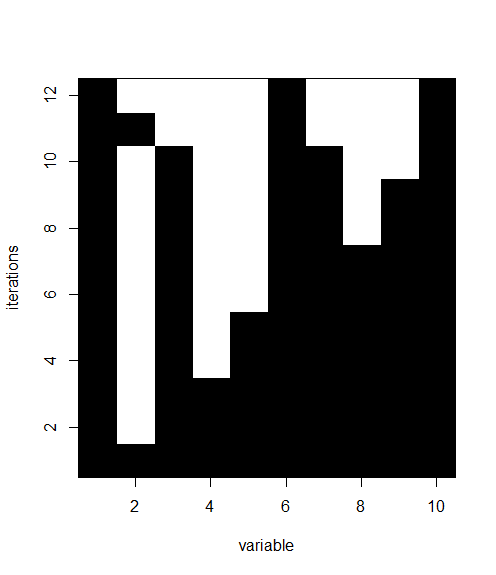Реализация поиска Tabu в R
Я пытаюсь внедрить Tabu Search в набор классификационных данных, а именно, болезнь печени индийских пациентов, доступную в хранилище UCI по https://archive.ics.uci.edu/ml/datasets/ILPD+(Indian+Liver+Patient+Dataset) но сталкиваюсь проблемы. Ниже приведен код, который я использовал
NF <- 10
NTR <- 193
NTE <- 193
library(class)
library(e1071)
library(caret)
library(party)
library(nnet)
ILPD <- read.csv("C:/Users/Dell/Desktop/Codes and Datasets/ILPD.csv")
nrow(ILPD)
set.seed(9850)
gp<-runif(nrow(ILPD))
ILPD<-ILPD[order(gp),]
idx <- createDataPartition(y = ILPD$Class, p = 0.7, list = FALSE)
train<-ILPD[idx,]
test<-ILPD[-idx,]
ver<-test[,11]
evaluate <- function(th){
if (sum(th) == 0)return(0)
model <- svm(train[ ,th==1], train[,11] , gamma = 0.1, kernel ="sigmoid", na.action = na.omit)
pred <- predict(model, test[ ,th==1])
csRate <- sum(pred == ver)/NTE
penalty <- (NF - sum(th))/NF
return(csRate + penalty)
}
library(tabuSearch)
res <- tabuSearch(size = NF, iters = 2, objFunc = evaluate, config = matrix(1,1,NF), listSize = 5, nRestarts = 4)
plot(res)
plot(res, "tracePlot")
summary(res, verbose = TRUE)
Ошибка:
Error in if (any(co)) { : missing value where TRUE/FALSE needed
In addition: Warning message:
In FUN(newX[, i], ...) : NAs introduced by coercion
Called from: svm.default(train[, th == 1], train[, 11], gamma = 0.1, kernel = "sigmoid", na.action = na.omit)
Некоторая часть данных
structure(list(age = c(55L, 48L, 14L, 17L, 40L, 37L), gender = c(0L,
0L, 0L, 0L, 1L, 0L), TB = c(0.9, 2.4, 0.9, 0.9, 0.9, 0.7), DB = c(0.2,
1.1, 0.3, 0.2, 0.3, 0.2), Alkphos = c(116L, 554L, 310L, 224L,
293L, 235L), SGPT = c(36L, 141L, 21L, 36L, 232L, 96L), sgot = c(16L,
73L, 16L, 45L, 245L, 54L), TP = c(6.2, 7.5, 8.1, 6.9, 6.8, 9.5
), ALB = c(3.2, 3.6, 4.2, 4.2, 3.1, 4.9), AG = c(1, 0.9, 1, 1.55,
0.8, 1), Class = structure(c(2L, 1L, 2L, 1L, 1L, 1L), .Label = c("One",
"Two"), class = "factor")), .Names = c("age", "gender", "TB",
"DB", "Alkphos", "SGPT", "sgot", "TP", "ALB", "AG", "Class"), row.names = c(216L,
405L, 316L, 103L, 20L, 268L), class = "data.frame")
Если кто-нибудь может помочь мне с этим
1 ответ
Я все равно хотел посмотреть, как работает табу, поэтому мне показалось, что это хорошее место для начала.
В основном вам нужно лучше тестировать свой код, evaluate просто не сработало. Это легко проверить вручную, создав значения th а потом звонит evaluate на них.
Также используйте высокоуровневые комментарии для организации своего кода и отслеживания того, что вы делаете, особенно при публикации в SO для получения помощи, чтобы сэкономить нам время на выяснение ваших намерений.
Не уверен, что эти результаты хорошие, объем данных настолько минимален, что трудно сказать.
В любом случае вот измененный код:
NF <- 10
NTR <- 193
NTE <- 193
library(class)
library(e1071)
library(caret)
library(party)
library(nnet)
ILPD1 <- structure(
list(
age = c(55L,48L,14L,17L,40L,37L),
gender = c(0L,0L,0L,0L,1L,0L),
TB = c(0.9,2.4,0.9,0.9,0.9,0.7),
DB = c(0.2,1.1,0.3,0.2,0.3,0.2),
Alkphos = c(116L,554L,310L,224L,293L,235L),
SGPT = c(36L,141L,21L,36L,232L,96L),
sgot = c(16L,73L,16L,45L,245L,54L),
TP = c(6.2,7.5,8.1,6.9,6.8,9.5),
ALB = c(3.2,3.6,4.2,4.2,3.1,4.9),
AG = c(1,0.9,1,1.55,0.8,1),
Class = structure(c(2L,1L,2L,1L,1L,1L),
.Label = c("One","Two"),
class = "factor")
),
.Names = c("age","gender","TB","DB","Alkphos",
"SGPT","sgot","TP","ALB","AG","Class"),
row.names = c(216L,405L,316L,103L,20L,268L),
class = "data.frame"
)
ILPD <- ILPD1
#ILPD <- read.csv("ILPD.csv")
nrow(ILPD)
set.seed(9850)
# setup test and training data
gp <- runif(nrow(ILPD))
ILPD <- ILPD[order(gp),]
idx <- createDataPartition(y = ILPD$Class,p = 0.7,list = FALSE)
train <- ILPD[idx,]
test <- ILPD[ - idx,]
ver <- test[,11]
evaluate <- function(th) {
# evaluate the tabu for a value of th
# tabuSearch will use this function to evaluate points in its search space
#
# if everything is turned off just return zero as we are not interested
if(sum(th) == 0) return(0)
# we just want to train our svm on the columns for which th==1
svmtrn <- train[,th==1]
# but we need to have the Class varible as our label
if (is.null(trn$Class)) return(0)
# Train up an svm now
# Note that the first argument is the forumula we are training
model <- svm(Class~.,svmtrn,gamma = 0.1,kernel = "sigmoid",na.action = na.omit)
pred <- predict(model,test)
# now evaluate how well our prediction worked
csRate <- sum(pred == ver) / NTE
penalty <- (NF - sum(th)) / NF
return(csRate + penalty)
}
library(tabuSearch)
evaluate(matrix(1,1,NF))
res <- tabuSearch(size = NF,iters = 2,objFunc = evaluate,
config = matrix(1,1,NF),listSize = 5,nRestarts = 4)
plot(res)
plot(res,"tracePlot")
summary(res,verbose = TRUE)
Вот выходные результаты:
[1] 6 [1] 0.005181347 Tabu Settings Type = binary configuration No of algorithm repeats = 1 No of iterations at each prelim search = 2 Total no of iterations = 12 No of unique best configurations = 8 Tabu list size = 5 Configuration length = 10 No of neighbours visited at each iteration = 10 Results: Highest value of objective fn = 0.70518 Occurs # of times = 1 Optimum number of variables = 3 Optimum configuration: [1] 1 0 0 0 0 1 0 0 0 1
А вот и ваш сюжет:
